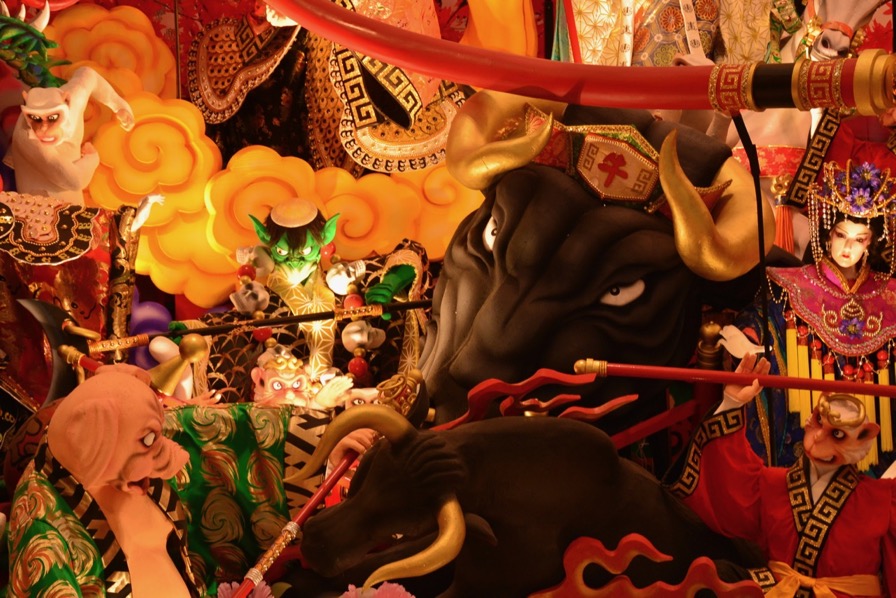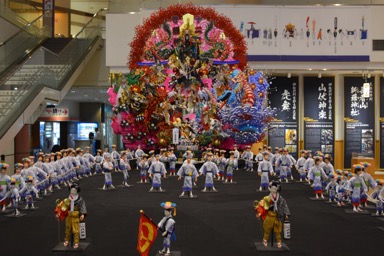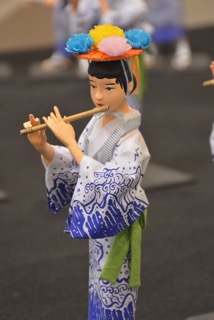Another festival
14/08/19 10:34

Misawa is about 15 miles from a larger town, Hachinohe. Hachinohe is on the Shinkansen or bullet train line that goes from Tokyo to Aomori. Misawa is served by the Aomori train line. You can ride the Aomori line to Misawa for about $6. That same train goes on to the city of Aomori. If you ride the Shinkansen past Hachinohe it will go directly to Aomori. The train then goes through a tunnel under the ocean to the island of Hokkaido. Folks who live in Misawa make trips to Hachinohe for shopping, medical care and a host of other reasons. They travel by train or by car, depending on the circumstances of the trip. We came by train from Tokyo to Hachinohe and then took the Aomori line to Misawa. We’ll return the same way. Yesterday we went to Hachinohe to make our Shinkansen reservations for our return to Tokyo for our flight home. While we were there, we took time to learn a bit about the city of Hachinohe.
When we came through Hachinohe on our way to Misawa, we arrived during the Sansha Taisai Festival. The Festival is celebrated between July 31 and August 4 each year and is one of many Japanese festivals that have been recognized by the United Nations as a World Natural and Cultural Heritage site. Like other festivals in Japan, the Sansha Taisai festival is marked by lanterns and parades with drums and flutes and elaborate floats. Unique to the Hachinohe festival, however, is a display of an ancient martial arts performed on horseback. Kagami-style Kiba Dakyu is held at the Chojasan Shinra Shrine as part of the festival. Kiba Dakyu is a form of traditional martial arts performed on horseback which has only three forms left in Japan. The Kagami-style Kiba Dakyu of Hachinohe is designated as an Aomori Prefectural Intangible Folk Cultural Property. Kiba Dakyu is similar to polo, two teams (red and white) with four riders each compete to score against the other team. Riders use sticks with a net on one end to hurl a ball in their goal to score.
While the big celebration and displays are held in Hachinohe, towns from around the area have riders who participate in the sport. In Misawa, we visited a place where some of the horses are kept. There are also small ponies kept in the same place. It was unclear to us whether or not the ponies are used as training animals for children to learn the sport.

Japan is often described as a secular culture, but people give reverence to festivals and shrines and celebrate their spirituality as well as their cultural traditions with great care and joy.
Because the focus of this trip to Japan has been our new grandson, we haven’t done many of the tourist activities and adventures that we might otherwise have experienced, but just being in Japan is an experience of a different culture. Although many Japanese people speak English, just riding on the train is an immersion into the Japanese language. We strain to pick out a few words from the train announcements and to recognize the names of the stations as we ride the train.
Each visit to a cultural site or display gives us an opportunity to learn more about the place we are visiting. Last year we spent an hour or so touring the Hachinohe fish market. Situated right on the coast, Hachinohe is home to a significant fishing fleet and the market is part of the distribution network of fresh fish. There are so many varieties of fish and ocean creatures that are sold in the market that we were amazed at the size and variety of the trade. Hachinohe also is a place of manufacturing of metal goods. Among the locally famous products are musical instruments including trumpets and other brass instruments. The region is also well known for fruit production and apples are especially well known local produce.
We have learned, through our experiences of travel, that it is impossible to get a full sense of the lives of other people from a short visit. There are many things to see and do that we miss, and spending a large part of our time on a US Air Force base means that we are never far from the culture, products and traditions of our home country. However, we are far enough from home to have a sense of visiting another country. Because we are especially interested in religion, the religious and cultural festivals capture our attention and give us insight into the lives of the people.

Our time in Japan is growing short. Our day trip yesterday reminded us that we soon need to be packing for the long trip home. Each experience in Japan is an opportunity to increase our understanding and appreciation of the people who live in this beautiful and interesting land. We are collecting memories that will last us for the rest of our lives. How grateful we are for being able to make this journey.